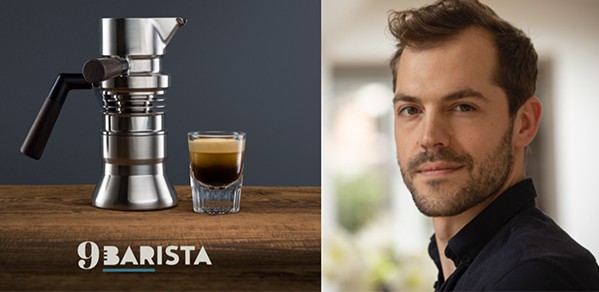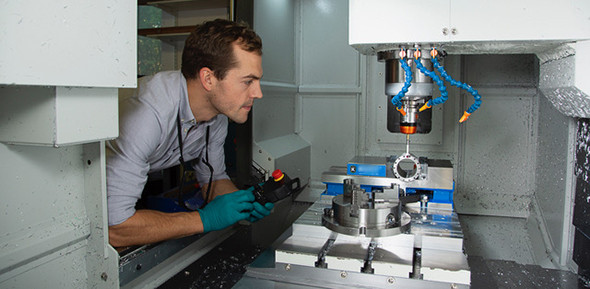
The first jet-engineered stovetop espresso machine, developed by a Cambridge alumnus, uses a new thermodynamic system to create high pressure brewing conditions.
I gained a lot of experience in instrumentation during my PhD, which was helpful for measuring the performance of some of the early 9Barista prototypes. The Whittle Lab also has a fantastic workshop, and some of the later production samples were manufactured on Whittle computer numerical controlled (CNC) lathes and milling machines.
Alumnus William Playford
It was during his PhD in the Department’s Whittle Laboratory five years ago that William Playford’s idea for 9Barista was borne. Inspired by his love for good coffee and his passion for jet engineering, William set about to create a new kind of stovetop espresso machine that could make the perfect coffee at high pressure, under controlled temperatures, and with precision engineered components to match – the same three elements required by a jet engine.
9Barista uses a unique twin-boiler system. One boiler sets the brewing pressure, while the second regulates the brewing temperature. It has no electrical components, and a spring-loaded valve is its only moving part.
Earlier this year, William launched 9Barista on global crowdfunding platform Kickstarter, and within just four days he had reached his funding target. He is now working on his first batch production (170 machines) for delivery to customers in the UK and abroad in October 2019. Around 90% of the machine is produced in the UK and he has a patent pending covering key global markets.
“The way 9Barista produces brew water at just the right pressure and temperature (9Bar and 93ºC) is completely new,” he said. “It is a very simple system with no electronics and one moving part, and this is what excited me about the design. I wanted to design a small, portable machine that had the simplicity and robustness of a traditional Moka pot, but with the performance of a high-end café-style espresso machine, at a price substantially lower than the leading brands.”
Life in the Whittle Laboratory
For his PhD titled Well Conditioned Heat Transfer measurements on Engine Scale Turbine Gas Rigs, William developed a measurement technique using infrared cameras that was used to measure heat transfer in an EU-funded (FACTOR framework) research turbine facility. The results from the measurements were used to fine-tune designs for lean-burn combustors in gas turbine engines, the overall aim being to reduce environmentally harmful nitrogen oxide (NOx) emissions.
“I gained a lot of experience in instrumentation during my PhD, which was helpful for measuring the performance of some of the early 9Barista prototypes,” he said. “The Whittle Lab also has a fantastic workshop, and some of the later production samples were manufactured on Whittle computer numerical controlled (CNC) lathes and milling machines.
“In the Whittle Lab, we do lots of work which involves measuring temperatures and pressures in jet engines (or at least models of jet engine components, in wind tunnels). Computers are usually used to log and analyse these measurements, in order to help spot interesting correlations. I used similar tools and techniques to analyse several espresso machines on the market. That helped build up an understanding of how water pressure and temperature affect espresso quality.
“Several of the 9Barista prototypes were also heavily instrumented in this way, and the measurement results were fed back into computer simulations of the coffee machine. The main objective was to understand how the machine was behaving, so that I could find ways of increasing the precision in the water temperature and pressure, whilst also making the machine produce a coffee faster.
“The Whittle Laboratory is really good at supporting ‘home projects’ which aren’t strictly related to the lab function. I think that’s one of its great strengths and definitely something that makes it a fun and interesting place to work,” he added.

William used the workshop in the Whittle Laboratory to manufacture some of the later production samples.
An engineering mindset
William is no stranger to designing products and has a history of taking on engineering design projects at home for fun, including rocket engines, jet engines, a remote control hovercraft, and even a lawnmower engine powered tricycle.
“It’s very exciting to see my idea for 9Barista come to fruition,” he said. “It’s taken a long time to develop it; the first sketch of the idea was back in 2013. During that development time there have been lots of really challenging engineering problems to solve, so I think one of the most pleasing things for me is to see all those solutions reliably working together, in what appears to be a very simple machine.”
Visit www.9barista.com for more information.

